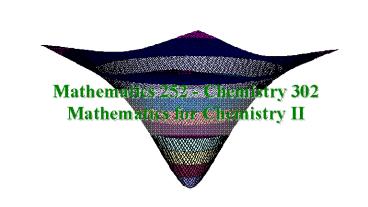Mathematics 252 Chemistry 302 Mathematics for Chemistry II - PowerPoint PPT Presentation
1 / 20
Title:
Mathematics 252 Chemistry 302 Mathematics for Chemistry II
Description:
Matrix eigenvalue-eigenvector problems. Math 252 Chem 302. Term Tests. week of Feb 11 15 ... Many problems in chemistry well suited for solution on a ... – PowerPoint PPT presentation
Number of Views:82
Avg rating:3.0/5.0
Title: Mathematics 252 Chemistry 302 Mathematics for Chemistry II
1
Mathematics 252 - Chemistry 302Mathematics for
Chemistry II
2
Math 252 Chem 302
- Instructor Dr. D. KeefeOffice TC-107 / TC-137
(laboratory)Phone 563-1185 / 1462
(laboratory)email Dale_Keefe_at_cbu.ca - Lectures T 1000 1115 am Th 830 945
am - Laboratories TBA.
- Mark Structure
- Laboratories / Assignments 40
- Term Tests 30
- Final Exam 30
3
Math 252 Chem 302
- Syllabus
- Solutions of nonlinear equations
- Solutions of systems of linear equations (matrix
inversion) - Interpolation / extrapolation
- Integration
- Least squares regression
- linear
- nonlinear
- Differential equations
- Matrix eigenvalue-eigenvector problems
4
Math 252 Chem 302
- Term Testsweek of Feb 11 15week of Mar 17
21 - must be written on the day they are scheduled.
- doctors certificate or other supporting document
to be eligible for a rewrite. - Otherwise a mark of 0 (zero) will be given for
the test - University closed ? test next scheduled lecture
period.
5
Math 252 Chem 302
- Supplementary ExaminationSupplementary
Examinations are NOT available for this course. - Office HoursTBA
- WebsiteAssignments, copies of lecture
transparencies and other course materials are
posted athttp//faculty.cbu.ca/dkeefe/chem302
6
Introduction
- Many problems in chemistry well suited for
solution on a microcomputer - Kinetics
- Quantum chemistry
- Spectroscopy
- Complexity
- Repetition
7
Introduction
- Use
- Maple
- Commercial Mathematics software
- Microsoft Excel
- Spreadsheet with some numerical applications
- C
- High-level programming language
- Write our own code
- Review Math 187 notes
8
Number Systems
- Understand how a computer stores information
- Decimal
- 10 integers (0,1,2,3,4,5,6,7,8,9)
- Decimal point
- positive () negative (-) signs
- Digits to left of decimal point represent
successive positive powers of ten - Digits to right of decimal point represent
successive negative powers of ten - 1234.56 ?1103 2 102 3 101 4 100 5
10-1 6 10-2 - Not practical for computers based on binary
states (on/off)
9
Number Systems
- Binary Base 2
- 2 integers (0,1)
- Binary point
- positive () negative (-) signs
- Digits to left of binary point represent
successive positive powers of two - Digits to right of binary point represent
successive negative powers of two - (1011.01)2 ?123 022 121 120 02-1
12-2
10
Number Systems
- Octal Base 8
- 8 integers (0,1,2,3,4,5,6,7)
- Octal point
- positive () negative (-) signs
- Digits to left of octal point represent
successive positive powers of eight - Digits to right of octal point represent
successive negative powers of eight - (1234.56)8 ?183 282 381 480 58-1
68-2
11
Number Systems
- Hexadecimal Base 16
- 16 integers (0,1,2,3,4,5,6,7,8,9,A,B,C,D,E,F)
- Hexadecimal point
- positive () negative (-) signs
- Digits to left of hexadecimal point represent
successive positive powers of sixteen - Digits to right of hexadecimal point represent
successive negative powers of sixteen - (1AF4.C6)16 ?1163 A162 F161 4160
C16-1 616-2
12
Number Systems
- Decimal Binary Octal Hexadecimal
- 0 0 0 0
- 1 1 1 1
- 2 10 2 2
- 3 11 3 3
- 4 100 4 4
- 5 101 5 5
- 6 110 6 6
- 7 111 7 7
- 8 1000 10 8
- 9 1001 11 9
- 10 1010 12 A
- 11 1011 13 B
- 12 1100 14 C
- 13 1101 15 D
- 14 1110 16 E
- 15 1111 17 F
13
Number Systems
- Decimal Binary Octal Hexadecimal
- 16 10000 20 10
- 17 10001 21 11
- 18 10010 22 12
- 19 10011 23 13
- 20 10100 24 14
- 21 10101 25 15
- 22 10110 26 16
- 23 10111 27 17
- 24 11000 30 18
- 25 11001 31 19
- 26 11010 32 1A
- 27 11011 33 1B
- 28 11100 34 1C
- 29 11101 35 1D
- 30 11110 36 1E
- 31 11111 37 1F
14
Converting between number systems
- Binary, Octal, Hexadecimal to Decimal
- Expand the powers of 2,8 or 16 into powers of 10
- (1011.01)2
- (123 022 121 120 02-1 12-2)2
- (18 04 12 11 0/2 1/4)10
- (11.25)10
15
Converting between number systems
- (1234.56)8
- (183 282 381 480 58-1 68-2)8
- (1512 264 38 41 5/8 6/64)10
- (668.71875)10
- (1AF4.C6)16
- (1163 A162 F161 4160 C16-1
616-2)16 - (14096 10256 1516 41 12/16
6/256)10 - (6900.7734375)10
16
Converting between number systems
- Decimal to Binary, Octal, Hexadecimal
- Convert the integer and fraction part separately
- Integer successively divide by 2, 8 or 16
keeping track of remainders - Fraction successively multiply by 2, 8 or 16
keeping track of integer part
17
Converting between number systems
18
Converting between number systems
19
Converting between number systems
20
Converting between number systems
- Between Binary, Octal, Hexadecimal
- 823 (use 3 binary digits for one octal digit)
- 1624 (use 4 binary digits for one hexadecimal
digit)

